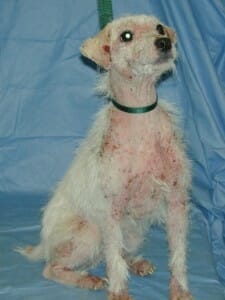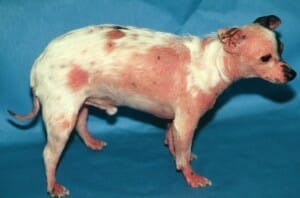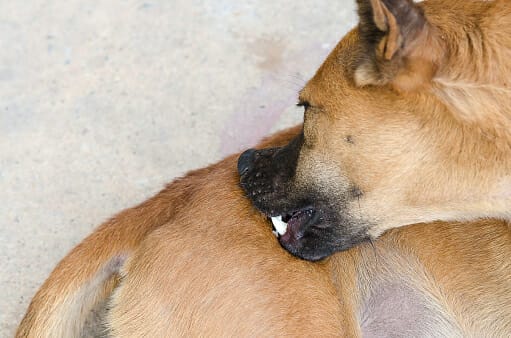
Mange in Dogs: Canine Demodex Diagnoses and Treatment
Demodex mites on healthy dogs are harmless but multiply on dogs with weakened immune systems, causing hair loss and skin lesions.
Dogs (and humans) have microscopic mites that live on the skin. In small numbers, they are generally harmless to dogs who have healthy immune systems. But for dogs that have an immature (puppies less than 18 months old) or weakened immune system, these mites can increase rapidly and cause hair loss and skin lesions. This condition is called canine demodicosis, often referred to as mange, and is caused by Demodex mites.

What are Demodex Mites?
The most common Demodex mite is Demodes canis and lives in the hair follicles. Dogs get these mites from their mother shortly after birth. Under normal conditions, mites remain low in number and do not cause lesions or disease. If mites multiple, they may cause:
- Hair loss (alopecia)
- Red skin (erythema)
- Red bumps (papules)
- Pimples (pustules)
- Purple-red blisters (hemorrhagic bullae)
- Black heads (comedones)
- Crust or scale
- Nodules
- Secondary skin bacterial infections
Demodex injai is another Demodex mite that may live in the oil glands (sebaceous glands) in the skin and hair follicles. Terrier breeds are most affected by rapid growth of Demodex injai. In large numbers, these mites can cause:
- Greasy skin
- Red skin
- Scale
- Hair loss
Diagnosing Canine Demodex
Your veterinarian will do skin scrapings or hair pluckings when there are lesions that indicate demodicosis. They will examine collected material under a microscope and, if mites are found, the diagnosis of canine demodicosis is confirmed. For certain lesion types or in certain breeds, veterinarians may need skin punch biopsies to detect the presence of Demodex mites deep within the lesion or in the sebaceous gland.
Canine demodicosis is categorized based on a dog’s age and the extent of lesions. These categories guide treatment and monitoring.
- Juvenile-onset demodicosis is diagnosed when a dog is less than 1 year old (2 for some breeds) at the onset of clinical signs. Most of these dogs develop lesions between 4 and 12 months. In addition to genetic and immunologic factors, we consider nutritional status, presence of other parasites, stress, heat cycles, and the possibility of other underlying diseases that may promote mite growth.
- Adult-onset demodicosis is diagnosed when the first clinical signs of disease occur after 1 or 2 years of age. For this group of dogs, we recommend diagnostic tests to screen for underlying conditions that would result in immunosuppression. Examples include conditions such as hyperadrenocorticism (excessive cortisol production by the body), hypothyroidism, other systemic diseases, or cancer. Dogs receiving chemotherapy or other immunosuppressive treatments can also be affected. Steroid administration is the most common cause of adult-onset demodicosis.
- Localized demodicosis is diagnosed when there are few lesions limited to a few body sites.
- Generalized demodicosis is diagnosed when there is widespread disease involving several body sites, any number of paws, or a whole-body region.

Canine Demodex Treatment
Localized juvenile-onset demodicosis is monitored without additional treatment. It usually resolves over time as the dog’s immune system matures. All other forms of demodicosis are treated. Several flea and tick preventatives in the isooxazoline class of drugs are effective in the off-label (for a condition other than what it was approved for) treatment for demodicosis in dogs.
The goal of treatment is remission, which is achieved when there are two consecutive visits at which skin scrapings are negative for all life stages of the mite. Treatment is extended for a short period of time after this and can usually be suspended. If there is no recurrence after one year, a dog is considered cured. Relapses may occur, especially if an underlying cause is not identified and controlled. Relapses are usually seen within the first three to six months after treatment is discontinued. If this occurs, your veterinarian will restart treatment and often continue it long-term.
Demodicosis is not contagious from a dog with mange to a healthy one, as the condition develops only with an immature or weakened immune system.
If your dog is showing signs of demodicosis (mange), seek guidance from your veterinarian or a MedVet dermatologist near you!
FAQs
What are demodex mites?
What are signs of demodex mites?
How is canine demodex treated?
Contents


